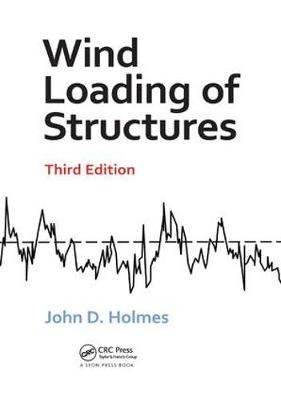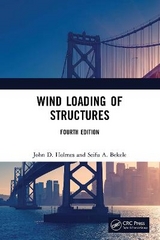
Wind Loading of Structures
Routledge (Verlag)
978-1-138-89397-9 (ISBN)
- Titel erscheint in neuer Auflage
- Artikel merken
Wind forces from various types of extreme wind events continue to generate ever-increasing damage to buildings and other structures. Wind Loading of Structures, Third Edition fills an important gap as an information source for practicing and academic engineers alike, explaining the principles of wind loads on structures, including the relevant aspects of meteorology, bluff-body aerodynamics, probability and statistics, and structural dynamics.
Written in Line with International Standards
Among the unique features of the book are its broad view of the major international codes and standards, and information on the extreme wind climates of a large number of countries of the world. It is directed towards practicing (particularly structural) engineers, and academics and graduate students.
The main changes from the earlier editions are:
Discussion of potential global warming effects on extreme events
More discussion of tornados and tornado-generated damage
A rational approach to gust durations for structural design
Expanded considerations of wind-induced fatigue damage
Consideration of aeolian vibrations of suspended transmission lines
Expansion of the sections on the cross-wind response of tall slender structures
Simplified approaches to wind loads on "porous" industrial, mining, and oil/gas structures
A more general discussion of formats in wind codes and standards
Not dedicated to a specific code or standard, Wind Loading of Structures, Third Edition highlights the general format and procedures related to all major codes and standards, addresses structures of various types, and presents you with topics not typically covered in traditional texts such as internal pressures, fatigue damage by wind forces, and equivalent static wind load distributions.
Dr. John D. Holmes is the director of JDH Consulting, Mentone, Victoria, Australia. He has a BSc (Eng.) from the University of Southampton, UK, and a PhD from Monash University, Australia. He is the author of more than 400 papers and reports. He received the Senior Award (A.G. Davenport Medal) from the International Association for Wind Engineering in 2011. He has been involved in the determination of design wind loads for many structures and industrial facilities, as well as the writing of several Australian Standards, and is currently the chair of the Wind Loads Subcommittee for Australia and New Zealand.
The nature of wind storms and wind-induced damage
Introduction
Meteorological aspects
Types of wind storms
Wind damage
Wind-generated debris
Wind storm damage and loss prediction
Hurricane-damage modelling
Predicted effects of climate change
Summary
The following chapters and appendices
References
Prediction of design wind speeds and structural safety
Introduction and historical background
Principles of extreme value analysis
Extreme wind estimation by the Type I Distribution
The peaks-over-threshold approach
Parent wind distributions
Wind loads and structural safety
Wind load factors
Summary
References
Strong wind characteristics and turbulence
Introduction
Mean wind speed profiles
Turbulence
Modification of wind flow by topography
Change of terrain
Weakening of a tropical cyclone after a coast crossing
Other sources
Summary
References
Basic bluff-body aerodynamics
Flow around bluff bodies
Pressure and force coefficients
Flat plates and walls
Rectangular prismatic shapes
Circular cylinders
Fluctuating forces and pressures
Summary
References
Resonant dynamic response and effective static load distributions
Introduction
Principles of dynamic response
The random vibration or spectral approach
Effective static loading distributions
Aeroelastic forces
Fatigue under wind loading
Summary
References
Internal pressures
Introduction
Single windward opening
Multiple windward and leeward openings
Nominally sealed buildings
Modelling of internal pressures
Summary
References
Laboratory simulation of strong winds and wind loads
Introduction
Wind-tunnel layouts
Simulation of the natural wind flow
Modelling of structures for wind effects
Measurement of local pressures
Modelling of overall loads and response of structures
Blockage effects and corrections
Computational wind engineering
Summary
References
Low-rise buildings
Introduction
Historical
General characteristics of wind loads on low-rise buildings
Buildings with pitched roofs
Multi-span buildings
Effects of parapets on low-rise buildings
Effect of building length
Internal pressures
A case study: optimum shaping of a low-rise building
Wind-tunnel databases
Summary
References
Tall buildings
Introduction
Historical
Flow around tall buildings
Cladding pressures
Overall loading and dynamic response
Combination of along- and cross-wind response
Torsional loading and response
Interference effects
Damping
Motion perception and acceleration criteria
Directionality
Case studies
Summary
References
Large roofs and sports stadiums
Introduction
Wind flow over large roofs
Arched and domed roofs
Effective static load distributions
Air-supported roofs
Wind-tunnel methods
Case studies
Summary
References
Towers, chimneys and masts
Introduction
Historical
Basic drag coefficients for tower sections
Dynamic along-wind response of tall slender towers
Cross-wind response of tall slender towers
Cooling towers
Guyed masts
Wind turbine towers
Case studies
Summary
References
Bridges
Introduction
Basic force coefficients for bridges
The nature of dynamic response of long-span bridges
Wind-tunnel techniques
Vibration of bridge cables
Case studies
Summary
References
Transmission lines
Introduction
Structural response and calculation of wind loads
Risk models for transmission line systems
Wind-induced vibrations of transmission lines
Summary
References
Other structures
Introduction
Walls and hoardings
Free-standing roofs and canopies
Attachments to buildings
Antennas
Lighting frames and luminaires
Industrial complexes and offshore platforms
Summary
References
Wind-loading codes and standards
Introduction
General descriptions
Basic wind speeds or pressures
Modification factors on wind velocity
Building external pressures
Building internal pressures
Other shapes and sectional force coefficients
Dynamic response calculations
Inter-code comparisons
General comments and future developments
References
A: Terminology
B: List of symbols
Probability distributions relevant to wind engineering
Extreme wind climates - A world survey
E: Some approximate formulas for structural natural frequencies
F: Example of application of the LRC method for the effective static wind loads on a simple structure
| Erscheinungsdatum | 07.10.2017 |
|---|---|
| Zusatzinfo | Approx. 375 line equations; 603 total equations; 37 Tables, black and white; 210 Illustrations, black and white |
| Verlagsort | London |
| Sprache | englisch |
| Maße | 178 x 254 mm |
| Gewicht | 794 g |
| Themenwelt | Technik ► Bauwesen |
| ISBN-10 | 1-138-89397-8 / 1138893978 |
| ISBN-13 | 978-1-138-89397-9 / 9781138893979 |
| Zustand | Neuware |
| Informationen gemäß Produktsicherheitsverordnung (GPSR) | |
| Haben Sie eine Frage zum Produkt? |
aus dem Bereich



